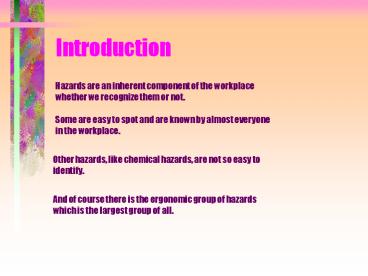HAZARD RECOGNITION - PowerPoint PPT Presentation
Title:
HAZARD RECOGNITION
Description:
Title: HAZARD RECOGNITION & CONTROL Author: THG Last modified by: THG Created Date: 6/13/1998 12:46:12 PM Document presentation format: On-screen Show – PowerPoint PPT presentation
Number of Views:588
Avg rating:3.0/5.0
Title: HAZARD RECOGNITION
1
Introduction
Hazards are an inherent component of the
workplace whether we recognize them or not.
Some are easy to spot and are known by almost
everyone in the workplace.
Other hazards, like chemical hazards, are not so
easy to identify.
And of course there is the ergonomic group of
hazards which is the largest group of all.
2
Hazards We Normally Recognize
- Vibration
- Excessive Noise
- Unguarded Machinery
3
Hazards Not So Easy to Identify
- Chemical Hazards
- Poisons
- Carcinogens
- Toxic Substances
4
Ergonomic Hazards
- Lifting
- Reaching
- Stretching
- Pushing
- Twisting
5
HAZARD RECOGNITION CONTROL
- There are many hazards in the workplace.
- Types of Hazards
- 1. Noise
- 2. Flying objects
- 3. Manual handling
- 4. Chemical hazards
- 5. Etc.
6
Minimize and Control Risks
- With an effective system of
- RECOGNITION
- EVALUATION OF RISKS
- CONTROL
7
RECOGNITION
- The first step.
- In many cases hazards are obvious-in others they
are not. - Examples of those not so obvious.
8
EVALUATION
- Is The Risk Acceptable?
- Can We Control It?
- How Can We Evaluate Risk?
- 1. Experience
- 2. Scientific Measurements
- 3. Outside Consultants
9
CONTROL
- Elimination- the ultimate form of control.
- Can we eliminate a process, substance,
- or activity.
- Examples-
- Combustible to non-combustible material
- Eliminate material handling
- Remove sharp edges, protruding objects
10
CONTROL, continued
- Substitution- Can we substitute a chemical or
activity for a less hazardous one? - Ask a series of Can We questions
- Have a toxic substance supplied in a different
form? - Have a toxic substance supplied in a lower
concentration? (59 vs 85)
11
Can We Questions, cont.
- Reduce the handling of a chemical by having it
delivered to a different location? - Divide a load to make it easier to handle?
- Reduce the level of airborne contaminants?
12
Unfortunately..
- Elimination and substitution are only practical
and fully effective in dealing with some
hazardous situations------ - So we must use Administrative and Engineering
Controls also.
13
CONTROLS, continued
- Administrative Controls-
- 1. Establish procedures.
- 2. Monitoring of Contaminants.
- 3. Organizing Hazardous Operations when small
numbers of people are present. - (e.g., between shifts or after working
hours) - 4. Rotation of workers to reduce exposure to a
particular hazard.
14
CONTROLS, continued
- Engineering Controls-
- 1. General design of workplace, plant or
equipment. - 2. Installation of additional lighting.
- 3. Use of automation and mechanical devices.
- 4. Isolation- isolate hazardous activities from
large groups of workers. (e.g., storage of
materials, noise enclosure, guards, warning
devices and interlocks.
15
Engineering Controls, cont.
- 5. Containment- Remove contaminants by air
movers- containing the hazard at its source. - 6. Limitation- Limit the effect of a potential
hazard safety valves installed, using low
voltage, low power or batteries.
16
CONTROLS, continued..
- Personal Protective Equipment- Only effective
when all other options are not satisfactory or
practical. - Or in normally hazardous operations such as
welding, spraying or confined space. - Or in emergency situations or confined space
entry when hazards are unknown.
17
PPE, Continued
- We shouldnt confuse the role of PPE as a
control measure with its more widespread role as
a precaution. - PPE is the Last Line of Defense
18
SUMMARY
- 1. Recognize that a hazard exists.
- 2. Make an objective or scientific evaluation.
- (do we need to control it)
- 3. Implement a control strategy
- a. Elimination
- b. Substitution
- c. Administration

